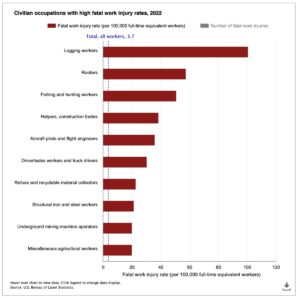Editor’s Notes: Death on the Job
Fatalities from Falls Continue to Rise
 It seems like the U.S. Bureau of Labor Statistics releases its report of Job Fatalities later every year, and once again, they held true to form. Their report on 2022 Job Fatalities Report was released on December, 19, 2023 with modifications/corrections made January 29, 2024… so the figures presented here are more than a year out of date.
It seems like the U.S. Bureau of Labor Statistics releases its report of Job Fatalities later every year, and once again, they held true to form. Their report on 2022 Job Fatalities Report was released on December, 19, 2023 with modifications/corrections made January 29, 2024… so the figures presented here are more than a year out of date.
In this age of instant access and information overload, it’s refreshing to see our federal bureaucracies are still operating slower than a herd of snails traveling through peanut butter. No threat of overwork or job stress here. None-the-less, these figures are as up-to-date as it’s going to get for another year.
I understand that a death on the job is not a pleasant subject, and I know of several contractors who have gone through this terrible experience. Even one death is a tragedy, and I’m not making light of the situation, but merely presenting the numbers as compiled by the U.S. Bureau of Labor Statistics.
There was a total of 5,486 fatal work injuries recorded in the United States in 2022, a 5.7% increase from the 5,190 fatal injuries reported during the previous year. While this increase was small, the economy was improving during that time and there were more people employed. The only guaranteed way to reduce this number to zero fatalities is for everyone to be out of work.
By far, the most dangerous industry is, was, and will probably continue to be, highway transportation, accounting for 1,620 transportation-related deaths in 2022, or 29.5% of the total. Highway deaths have topped the U.S. Bureau of Labor Statistics list for as long as they’ve been keeping track using their current system, and this isn’t likely to change.
Construction deaths accounted for the second highest most dangerous occupational group with 1056 of the total fatalities in 2022, or 19.2%. This is a rate of 12.6 deaths per 100,000, and the fourth highest rate for all civilian occupations. Higher per 100,000 fatality rates were recorded by the fishing industry, logging, and aircraft pilots respectively.
Out of the 1056 construction deaths, falls (including from ladders, scaffolds, roofs, or through openings) accounted for 423, or 20.8%, of all construction worker fatalities in 2022. Fatal falls were at their highest level in the 33-year history of the Census of Fatal Occupational Injuries (CFOI). Falls continue to account for the vast majority of on-the-job fatalities; and the total has steadily increased each year, without fail, for the past decade. This is the reason OSHA is on your case regarding ladder safety.

Fatalities due to violence and other injuries by persons or animals increased 11.6 % to 849 in 2022, compared to 761 in 2021. Homicides accounted for 61.7% of these fatalities, with 524 deaths, an 8.9% increase from 2021. Almost a quarter (24.6%) of fatalities were due to homicides that occurred while a worker was tending a retail establishment or waiting on customers. Suicides increased 13.1% to 267 fatalities in 2022. This follows consecutive decreases in the previous two years.
Men account for 53% of the nation’s workforce while women account for 47%. Ninety-two percent of all on-the-job fatalities were male while only 8% were female. These statistics are most likely due to the fact that men occupy more jobs than women in both transportation and construction, the two most dangerous categories. Don’t shoot the messenger. The U.S. Bureau of Labor Statistics compiled the figures, I just report them.
If you just can’t get enough of these labor statistics, go to https://www.bls.gov/iif/home.htm.

Marc Dodson
editor